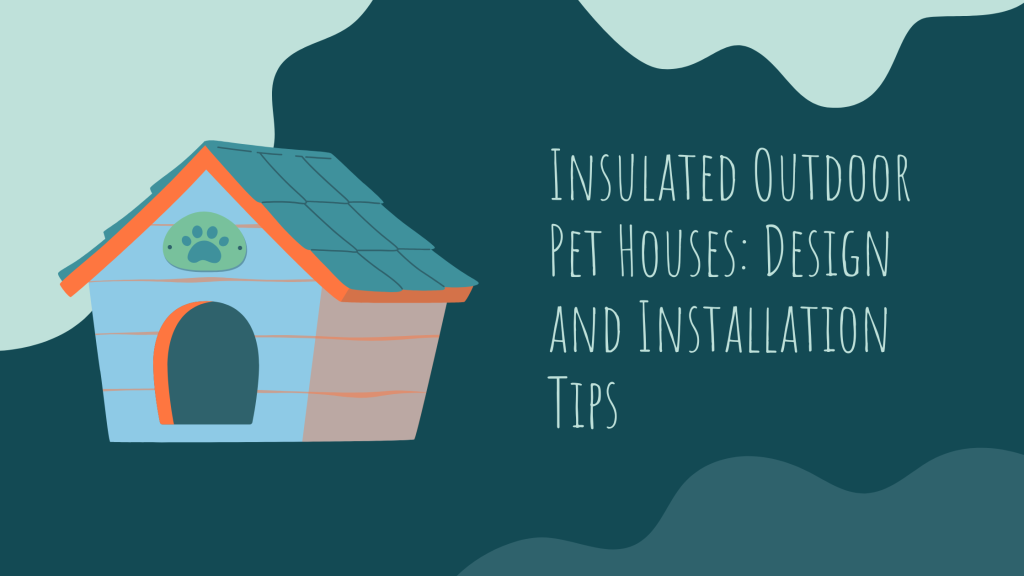Why Insulation Matters for Outdoor Pet Houses
When it comes to pet housing solutions, the insulation of an outdoor pet house is often overlooked, but it plays a crucial role in ensuring your pet’s safety and comfort. Just like you would insulate your own home to protect against extreme temperatures, insulating your pet’s house helps create a stable, cozy environment for them year-round. Let’s explore why insulation matters for outdoor pet houses.
Protecting Pets from Extreme Weather
Imagine this: you live in a region where winters are brutal, and the temperatures often drop well below freezing. Without proper insulation, your pet’s outdoor house could become a cold, uncomfortable shelter that exposes them to frostbite or even hypothermia.
Take, for example, a family in Alaska with a large, outdoor dog kennel. Without insulation, the dog house could easily turn into a freezing cold box during the long winters. But by installing insulated pet houses, they ensure that their dogs stay warm and protected, even in the harshest conditions. Insulation traps the warmth inside, providing a much-needed barrier against frigid winds.
In summer, insulation also prevents the house from turning into an oven. It keeps your pet’s outdoor space cool and breathable, even on the hottest days, allowing them to relax in comfort.
Enhancing Comfort and Reducing Stress
In addition to temperature regulation, insulation helps to reduce stress for pets. Think about the discomfort a pet might experience in a hot, stuffy house during the summer. Now, imagine the same pet, in the same house, but with effective insulation that helps keep the temperature regulated.
For example, if you have a senior cat who’s sensitive to extreme weather, an insulated outdoor pet house can provide a peaceful, consistent temperature that reduces the stress and anxiety that might come with fluctuating conditions. In this way, your pet’s overall well-being improves, and they’ll feel safer in their environment.
Choosing the Right Pet House Materials for Insulation
When you start considering pet house materials, the choices you make can make all the difference in how well the house retains heat or keeps out the cold. Let’s take a look at some materials that can help you achieve the best insulation.
Recommended Insulating Materials
Choosing the right insulating materials is critical. For example, foam insulation is a popular choice due to its effectiveness in regulating temperature. A pet house design with foam insulation, combined with sturdy walls, can make a noticeable difference in your pet’s comfort.
Some other great options for insulation include reflective insulation, which works by reflecting heat back into the house, and wool-based materials, which are natural insulators. The key here is to select materials that are safe for your pet, as well as those that offer maximum protection against the elements.
Avoiding Problematic Materials
Not all materials are created equal, and some could actually be harmful to your pet or ineffective in insulation. For instance, materials like cheap Styrofoam, while inexpensive, may not hold up well in the elements and can break apart easily, causing potential hazards for your pet. Similarly, certain plastics may not be breathable and could lead to excessive condensation inside the pet house, creating a damp and uncomfortable environment.
A friend of mine once tried to build an outdoor eco-friendly pet house using recycled plastic. Unfortunately, the plastic didn’t allow enough airflow and trapped moisture, which led to mold growth inside. This is why it’s so important to choose materials carefully and ensure they’re suitable for your local weather conditions.
Designing an Insulated Outdoor Pet House
Once you’ve selected the right materials, it’s time to think about the design of the pet house. Here’s how to approach the design process to ensure maximum comfort for your pet.
Essential Features for Insulated Pet Houses
An insulated pet house design should include several essential features. The entrance, for example, should be designed in a way that minimizes heat loss. You might consider adding a flap or a double door to prevent cold drafts from entering when your pet comes and goes.
Another key feature is elevated flooring. Raised floors help prevent moisture from seeping into the house and reduce the chances of the house becoming damp. Additionally, insulation between the floor and the walls helps keep the heat inside.
Lastly, ensure that your pet housing solutions are easy to clean. A pet house with a removable roof or floor makes it easier to keep the space dry and hygienic, which is essential for your pet’s health.
Customizing for Your Pet’s Needs
Not all pets have the same needs, so customizing the design of your insulated outdoor pet house can make a world of difference. For example, if you have a dog with long fur, you may need to adjust the pet house size guide to ensure there’s plenty of space for them to stretch out, while still maintaining the warmth inside.
For a cat, consider adding a soft interior bed or padded walls to keep them cozy. Some pets prefer a darker environment, while others might like a little light. Think about your pet’s individual preferences when designing their new home.
Installation Tips for Insulated Outdoor Pet Houses
Once you’ve designed your insulated pet house, it’s time to think about installation. Here are a few tips to ensure a smooth installation process.
Choosing the Best Location
When considering where to install your pet house, try to avoid spots where wind or rain can directly affect the structure. Place the house in a shaded area to provide coolness during the summer and prevent excessive sun exposure. If you have a particularly windy yard, you might want to install the pet house near a fence or wall for protection.
For example, if you have a backyard that gets a lot of afternoon sun, a corner near some trees could be an ideal location. Alternatively, installing it near the back of your house provides shade and protection, especially in the winter when the sun is low.
Proper Assembly Techniques
Be sure to follow all instructions carefully when assembling your insulated outdoor pet house. An improperly assembled structure may compromise the insulation and lead to poor temperature regulation. For instance, gaps or seams in the structure could allow cold air to seep in, diminishing the effectiveness of your insulation.
Also, double-check the stability of the house after assembly. You don’t want it to be prone to tipping over during a storm or heavy wind. A secure, sturdy foundation is essential.
Maintenance Tips for Long-Lasting Pet Housing Solutions
To ensure your pet house materials and design last for many years, proper maintenance is crucial.
Regular Cleaning and Upkeep
The cleanliness of your pet’s house directly affects their comfort and health. Regular cleaning helps prevent the buildup of dirt, mold, and bacteria. Wipe down surfaces with pet-safe cleaning products and regularly check the insulation for any damage.
For example, if you’ve installed eco-friendly pet houses made from natural materials, you’ll want to ensure that they’re not subject to excess moisture, which could lead to rotting or mold growth.
Seasonal Inspections
Make it a habit to inspect the pet house at the beginning of each season. Look for any signs of wear and tear, particularly around the entrance and insulation. Check that the materials are still intact and haven’t been compromised by weather or pests.
Eco-Friendly Insulated Pet Houses: Design and Benefits
An eco-friendly pet house not only supports sustainability but also provides a healthy, comfortable environment for your pet.
Sustainable Materials for Insulated Designs
Materials like recycled plastic, bamboo, and cork are excellent eco-friendly options for constructing insulated pet houses. Not only do these materials offer good insulation properties, but they also help reduce your environmental impact. For instance, a bamboo pet house offers natural insulation while being biodegradable and renewable.
Energy-Efficient Pet Housing Solutions
Energy efficiency is another benefit of insulated pet houses. Using materials that retain heat and block out cold reduces the need for additional heating sources, keeping the house cozy without relying on energy-consuming devices.
Common Mistakes to Avoid When Designing and Installing Insulated Pet Houses
While designing and installing your insulated pet house, there are several common mistakes to avoid.
Overlooking Ventilation
Proper ventilation is just as important as insulation. A pet house without proper airflow can become stale and damp, even with great insulation. Ensure there are vents or openings to allow fresh air to circulate.
Underestimating Pet House Size Needs
Choosing the right size is critical. A pet house that’s too small won’t provide enough space for your pet to move comfortably. At the same time, a house that’s too large could lose heat too quickly, making it less effective in extreme temperatures. Always follow the pet house size guide to ensure the right fit for your pet.



